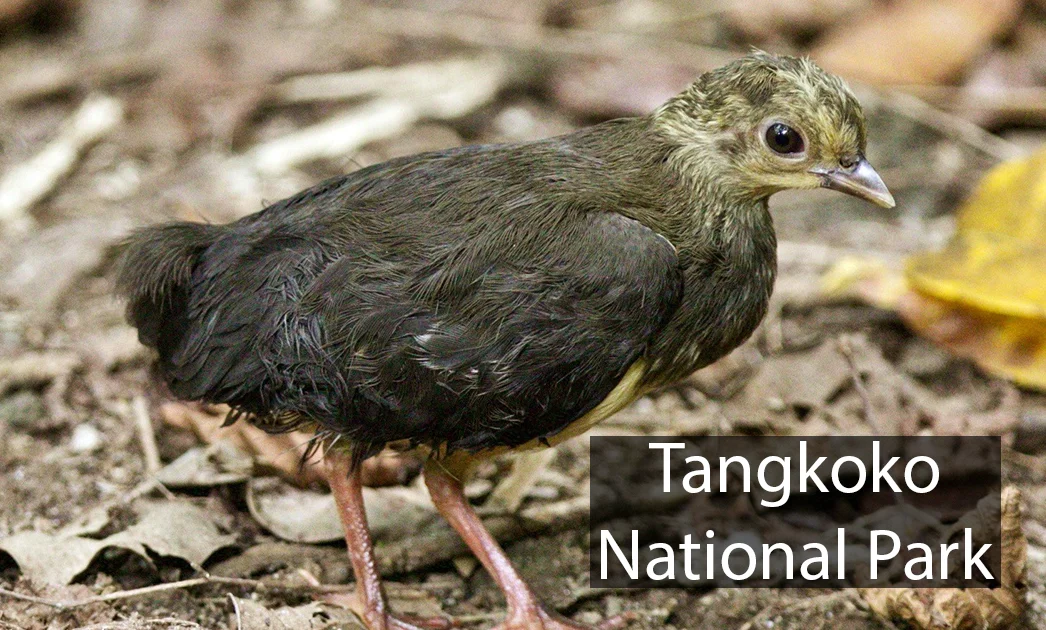Tangkoko National Park (Tangkoko Batuangus Nature Reserve)
Tangkoko National Park, also known as Tangkoko Batuangus Nature Reserve, is located at the northeastern tip of the northern peninsula of Sulawesi Island in Indonesia. Nestled between the islands of Lembeh and Bunaken, this park encompasses 8,867 hectares of lush rainforest surrounded by picturesque mountains and coastline. Tangkoko offers visitors a chance to discover Sulawesi’s incredibly diverse and endemic wildlife.
Location
Tangkoko National Park sits within the Minahasa Regency in North Sulawesi province, Indonesia. It stretches across the Batuangus and Tatapaan peninsulas, two mountainous forested peninsulas jutting out into the Molucca Sea. The park features three mountains – Mount Tangkoko, Mount Dua Sudara, and Mount Batuangus. These forest-cloaked peaks provide stunning vistas of the coastline dotted with secluded sandy beaches and hidden coves. Mangrove forests fringe many areas of the coast as well. The presence of various habitat types like rainforest, beach vegetation, and mangroves contributes to the diversity of species found here.
History
In 1919, the area first received protection as a nature reserve for forestry resources under Dutch rule. In 1965, Indonesia declared 8,867 hectares as a national park area for conservation and recreation. Tangkoko National Park was formally established in 1991 by the Indonesian Ministry of Forestry to help protect the distinctive and endangered wildlife found here. For many endemic Sulawesi species like anoa, black macaque, red-knobbed hornbill this park provides critical habitat. Active conservation, ecotourism activities, and research continue today to sustain this valuable reserve for rare wildlife.
Flora & Fauna of Tangkoko National Park
Tangkoko National Park, located on the northern tip of Sulawesi island in Indonesia, contains exceptionally diverse wildlife habitats ranging from sandy beaches, to lowland rainforest, mangroves and forested mountains. Over 135 mammal and nearly 250 bird species are found here, with new discoveries still occurring. Among these are extremely rare and endangered endemic animals that contribute to Tangkoko’s prestigious reputation in conservation circles.
Mangrove Forests
Lining much of the park’s coastline, mangrove forests form critical buffers against erosion and storm surges. Rhizophora apiculata and R. Mucronata mangroves dominate, featuring a thick tangle of prop roots that provide haven for fish, crab and shrimp. Mangrove tree species unique to Sulawesi like R. Sulawesii, R. Selala and R. Sanders also thrive here. The intricate root systems cradle a variety of wildlife including the Sulawesi black macaque, blue-eared kingfisher, brahminy kite and Pacific reef heron, all observed hunting amongst the trees.
Rare and Endangered Species
Several globally threatened species occur only on Sulawesi island and Tangkoko park provides vital refuge. The spectral tarsier, world’s smallest known primate weighing just over 100 grams, only inhabits certain rainforest patches here. Likewise, the extremely rare and cryptic bear cuscus lives solely within the park boundaries today. Reaching up to two feet long, this odd-looking marsupial is hunted extensively for food and the pet trade. Deforestation also threatens the endangered maleo bird that nests in the park’s tranquil sandy beaches. Conservation efforts underway aim to protect these and other vulnerable species.
Spectral Tarsier
Tiny tarsiers with bulging eyes even bigger than their brains roam Tangkoko’s dark rainforest understory. Weighing as little as two ounces, the spectral tarsier is a nocturnal hunter existing only on insects and some small vertebrates. Their unique vertical cling leaping locomotion allows them to jump up to 16 feet! Spectral tarsiers sleep together in groups high in strangler figs during the day. Sadly their limited distribution and specialized ecology causes great risk of extinction.
Bear Cuscus
This cryptic and threatened marsupial dwells in montane forests above 3,280 feet in Tangkoko reserve. Named for its thick fur and bear-like appearance, bear cuscuses feed on leaves, ferns and fungi high in the forest canopy. Bear cuscuses give birth to a single young after brief 4 week gestation period. Solitary and difficult to spot in the dense jungle, these mammals depend critically on conservation efforts as habitat vanishes across Sulawesi.
Maleo Bird
Listed as endangered, the maleo is a large megapode ground bird that constructs unusual volcanic sand nest mounds within Tangkoko park lands. Their eggs incubate for nearly 90 days buried in warm sand without parental supervision before hatching. Chicks emerge fully feathered and ready to fly from the nest, although the maleo continues protecting them. With low reproductive rates, chick and egg predation, and rampant egg harvesting by humans, as few as 10,000 maleos remain globally.
Activities to do in Tangkoko National Park
Encompassing stunning mountain forests, sandy beaches, mangroves and rainforest, Tangkoko National Park offers many recreational activities showcasing endemic wildlife and breathtaking scenery for nature lovers. From hiking forested peaks to waiting patiently for shy tarsiers to appear, a range of special experiences here cater to diverse interests.
Trekking and Hiking Trails
Tangkoko contains two popular hiking trails offering magnificent lookouts and waterfall views. The challenging Batuangus Viewpoint Trail ascends through lowland forest crossing nine riverbeds enroute to a spectacular coastline panorama at 1,312 feet on steep Mount Batuangus. Alternatively, the picturesque Duasudara Waterfall Trail features a 197 foot twin waterfall visible after a steady two hour rainforest trek.
Batuangus Viewpoint Trail
This strenuous six mile roundtrip hike offers stunning vistas of nearby Bunaken Island, volcanic Mount Klabat and lush rainforest from atop Mount Batuangus. The demanding trail traverses varied terrain from sandy beaches, grasslands, rivers and steep sections Scaling the mountain takes around four hours and decent fitness. Since visitors cannot stay overnight, completing the hike in one day before park closing requires an early morning start.
Duasudara Waterfall Trail
Accessed via the scenic Batuputih village, this trail cuts through mossy forest filled with endemic tropical plants to reach twin waterfalls named Duasudara at Tangkoko’s southern boundary near Mount Dua Saudara. Two river channels split and reunite creating the 197 foot parallel falls amid ferns, orchids and thick vegetation. Trekking time is under two hours one-way. The easy, relatively flat walk allows observing abundant bird life like vibrant red-knobbed hornbills flying overhead.
Wildlife Viewing
Visitors can readily spot a myriad wildlife species through patient observation aided by experienced local guides at Tangkoko. The most iconic and highly sought-after sighting remains the spectral tarsier – the palm-sized “ghost of the forest” best seen at dawn or dusk.
Primate Watching
Eight primate species forage in Tangkoko including rare black macaques, the bear cuscus and smallest of all – the spectral tarsier. Weighing a mere two ounces, huge eyed tarsiers leap vertically up to 16 feet hunting insects! Skilled guides assist with night hikes to admire these captivating nocturnal creatures as they awaken under bright spotlights.
Birdwatching
From vibrant red-knobbed hornbills soaring over the forest canopy to maleo birds quietly tending ground nests, exceptional bird watching thrives across Tangkoko. Endangered maleos build large mound nests on quiet beaches allowing their eggs to incubate buried in warm volcanic sand. Birders may also spot kingfishers, fruit doves, rare finches and parrots.
Bat Watching at Bat Caves
At dusk, thousands of tiny Dusky fruit bats emerge enmasse from three enormous caves within the Duasudara trail circling upwards in funnel clouds above the rainforest. Their polarization sonar and synchronized flights create mesmerizing patterns against the sunset. Local conservation groups now protect these caves once heavily mined for bat guano fertilizer. Rangers lead guided tours including the bat exodus providing powerful glimpses into primordial nature.
Conservation Efforts
Given its exceptional biodiversity and numerous endemic animals facing extinction, conservation represents a central focus protecting Tangkoko National Park for future generations. Various threats from poaching to habitat destruction challenge native wildlife struggling to endure amongst shrinking forests and heavy hunting pressure. Intensive patrolling, research studies and community partnerships now reinforce preservation initiatives across this sensitive ecosystem.
Threats and Challenges
Deforestation
Rampant logging and land conversion to agriculture plague habitats surrounding the park, isolating its forest ecosystem. Selective illegal tree cutting also occurs inside park boundaries harming canopy specialists like tarsiers. Encroaching palm oil plantations near Tangkoko’s western border also destroy critical buffer habitat used by wide-ranging species for dispersal and seasonal migration.
Poaching
Extensive hunting by humans poses grave danger to endangered mammals like anoa, bear cuscus and maleo bird thriving almost exclusively within Tangkoko forests. These animals are prized for decorative horns and meat or captured alive for the pet trade. Constant patrols now aim to halt trapping efforts which severely threaten local extinction as traps cannot discriminate between common and rare species.
Conservation Initiatives
Patrols and Monitoring
Park rangers, researchers and volunteers conduct regular jungle patrols searching for snares, traps and pursuing illegal poachers in delicate areas. Infrared camera traps also monitor cryptic wildlife activity, population numbers and distribution which guides enhanced protection efforts in habitats favored by vulnerable species like the spectral tarsier.
Community Involvement
Conservation groups now include local indigenous communities in forest restoration projects, sustainable development programs and environmental education initiatives. Hiring villagers as park rangers and guides also generates vital income and shared interest preserving habitats supporting both wildlife and local livelihoods through carefully managed ecotourism. These initiatives help foster community stewardship protecting Tangkoko’s exceptional biodiversity.
Preparing For A Trip To Tangkoko National Park
Tangkoko National Park provides an amazing opportunity to discover endangered wildlife within lush rainforests, tranquil beaches and mangrove estuaries. Planning your trip carefully considering seasonal conditions, accommodation options and park regulations helps ensure a safe, enjoyable experience amid this unspoiled habitat.
Best Time to Visit Tangkoko National Park
The ideal months for exploration fall between July and October during the dry season with mild temperatures and sunny weather most days. Trails become challenging to navigate when monsoon rains peak November through April. Bundling up helps with early morning hikes combating cooler temperatures in higher mountainous areas. Visiting during holidays like Nyepi and Eid provides engaging cultural celebrations too.
Where to Stay Near Tangkoko National Park
Basic guesthouses in nearby villages or resorts on Lembeh and Bunaken islands offer convenient lodging. Spend a night immersed in nature within wonderfully rustic forest cottages at Tangkoko Lodge adjacent to park headquarters. Wake up and head straight to trailheads. Duasudara and Batuangus view cottages operated by PHPA also sit right inside the reserve for those willing to rough it sans electricity.
Rules and Regulations Within Tangkoko National Park
Entry permits cost around $8 per person payable at the gate. Visitors must hire authorized local guides at reasonable cost for any hike, snorkel trip or sightseeing tour. Night tours are restricted to four people maximum with two guides to minimize disturbance locating nocturnal creatures. Loud noises are prohibited along with removing vegetation, feeding wildlife or wandering off designated trails that could damage sensitive areas.
Significance of the Tangkoko National Park
Harboring over 40% of Sulawesi’s mammals and half its birds, Tangkoko’s 8,867 hectares punches far above its weight sheltering biodiversity. Over 50% of its 135 mammal and 249 bird species exist only on Sulawesi, like the spectral tarsier and maleo bird. These tropical forests also nurture four additional Asian primates, 72 reptiles and 29 bat varieties – including rare species attracting researchers worldwide. Protecting this habitat ensures future studyunlocking evolutionary secrets.
Call For Conservation
While Tangkoko National Park CONTACT governs this area, threats from hunting and deforestation remain ever-present. Preserving interconnected habitat corridors for lowland forest specialists to disperse requires landscape level cooperation with surrounding communities. Supporting alternative sustainable livelihoods, conservation education and participation in management protects parks like Tangkoko for generations. Though small in size, safeguarding Sulawesi’s endemic biodiversity depends heavily on the fate of fragile reserves like this.




